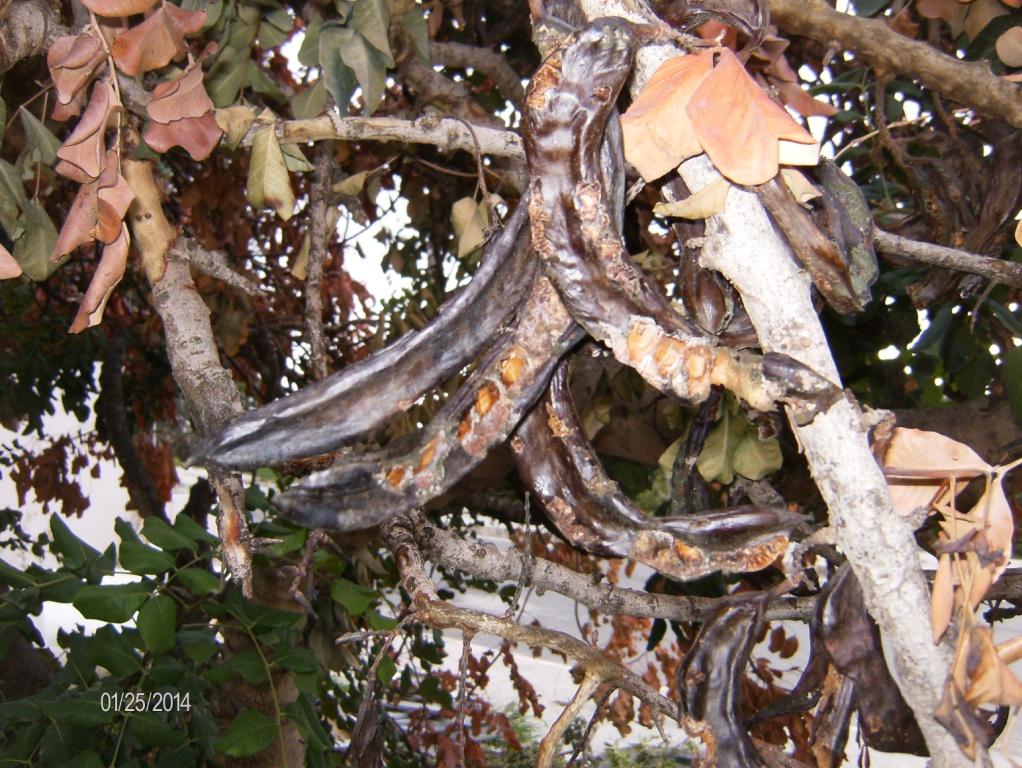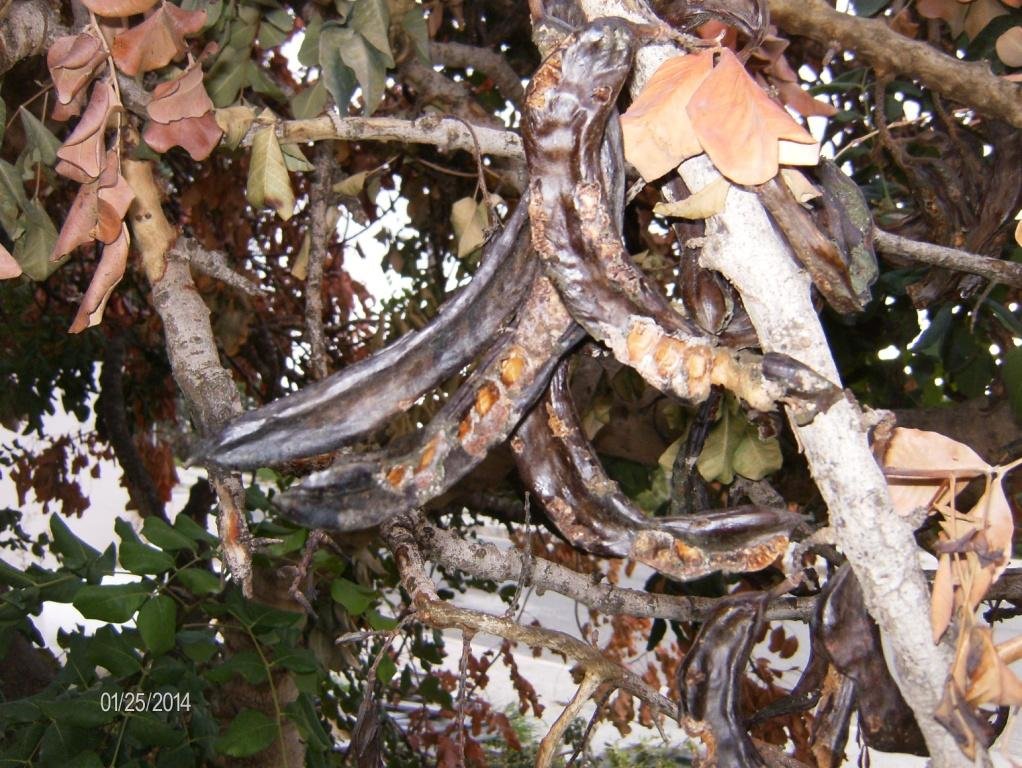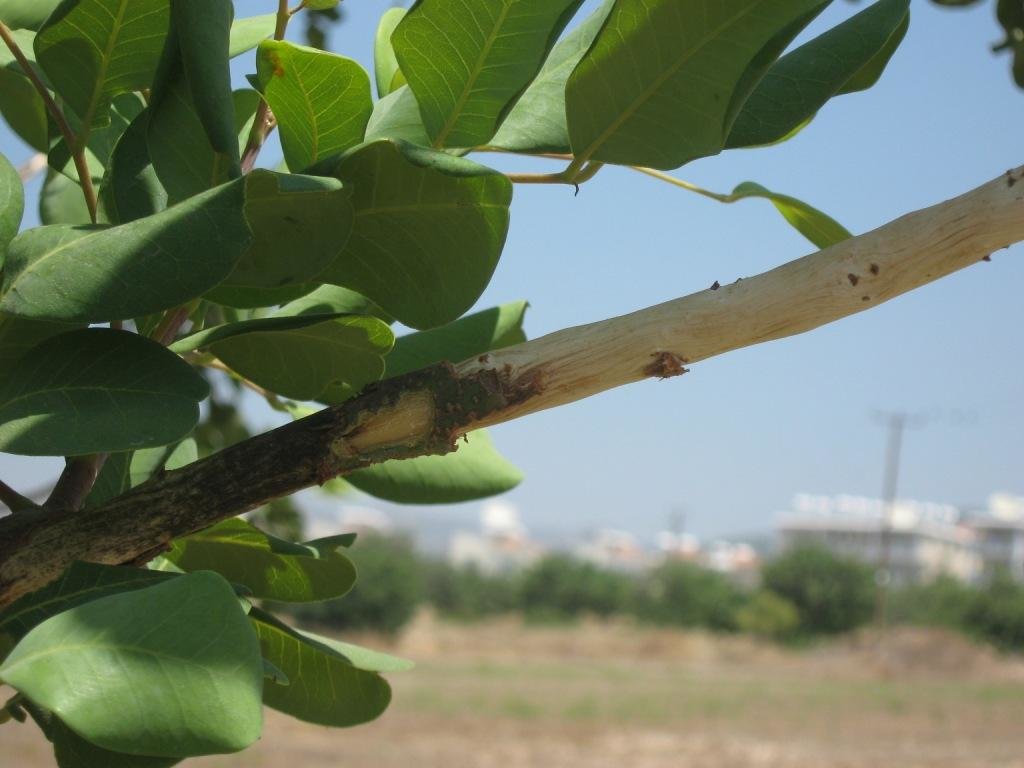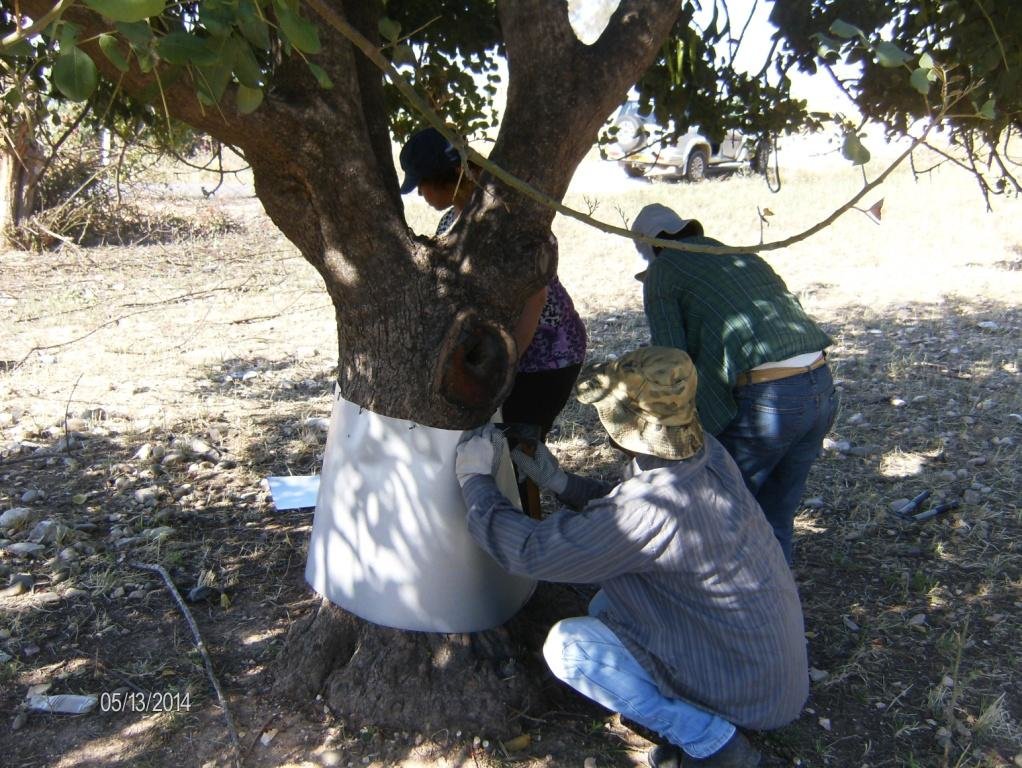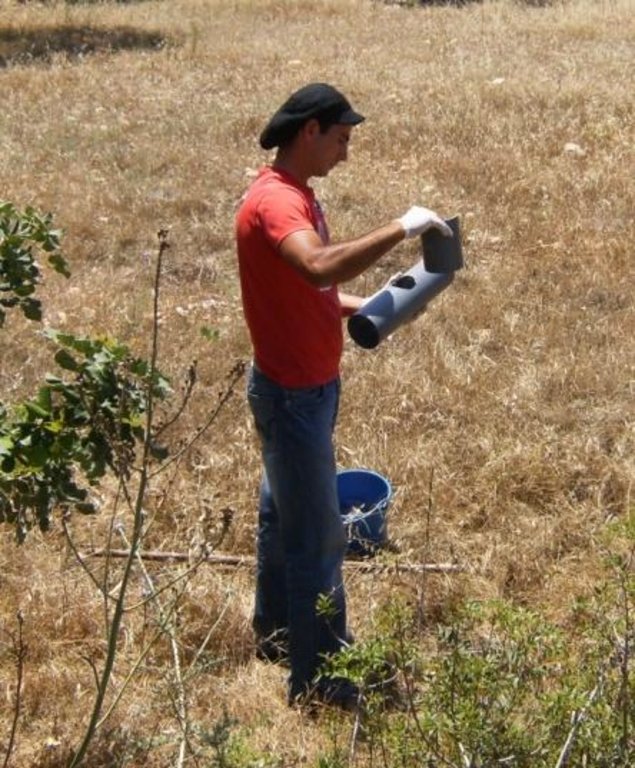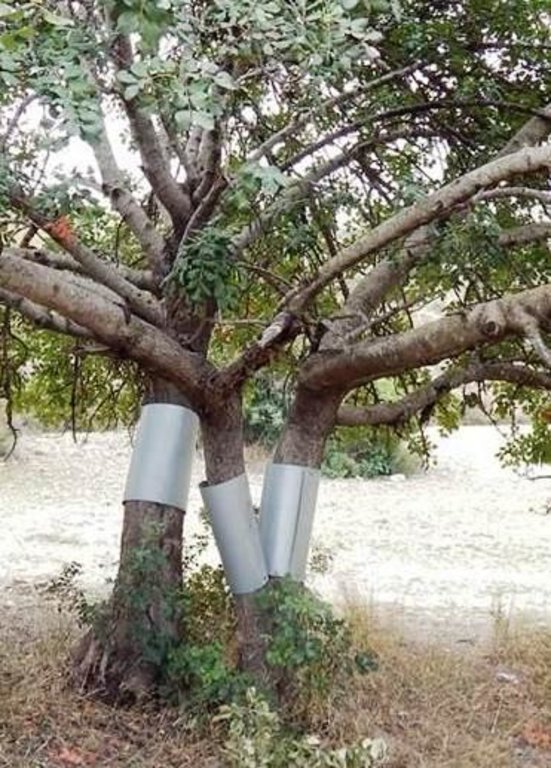Carob tree protection from rats [ប្រទេសស៊ីប]
- ការបង្កើត៖
- បច្ចុប្បន្នភាព
- អ្នកចងក្រង៖ Michalakis Christoforou
- អ្នកកែសម្រួល៖ –
- អ្នកត្រួតពិនិត្យ Fabian Ottiger
Προστασία χαρουπόδενδρων απο προσβολές αρουραίων και ποντικών
technologies_1703 - ប្រទេសស៊ីប
ពិនិត្យមើលគ្រប់ផ្នែក
ពង្រីកមើលទាំងអស់ បង្រួមទាំងអស់1. ព័ត៌មានទូទៅ
1.2 ព័ត៌មានលម្អិតពីបុគ្គលសំខាន់ៗ និងស្ថាប័នដែលចូលរួមក្នុងការវាយតម្លៃ និងចងក្រងឯកសារនៃបច្ចេកទេស
Governement official:
Costas Michael
+357-26-804567
costasmichael@ymail.com
Ministry of Agriculture, Rural Development and Environment, Cyprus
B18, Nicosia, Zypern
ប្រទេសស៊ីប
ឈ្មោះគម្រោងដែលបានចងក្រងឯកសារ/ វាយតម្លៃលើបច្ចេកទេស (បើទាក់ទង)
Catastrophic shifts in drylands (EU-CASCADE)ឈ្មោះអង្គភាពមួយ (ច្រើន) ដែលបានចងក្រងឯកសារ/ វាយតម្លៃបច្ចេកទេស (បើទាក់ទង)
Cyprus University of Technology (Cyprus University of Technology) - ប្រទេសស៊ីប1.3 លក្ខខណ្ឌទាក់ទងទៅនឹងការប្រើប្រាស់ទិន្នន័យដែលបានចងក្រងតាមរយៈ វ៉ូខេត
តើពេលណាដែលទិន្នន័យបានចងក្រង (នៅទីវាល)?
01/06/2014
អ្នកចងក្រង និង(បុគ្គលសំខាន់ៗ)យល់ព្រមទទួលយកនូវលក្ខខណ្ឌនានាទាក់ទងទៅនឹងការប្រើប្រាស់ទិន្នន័យដែលបានចងក្រងតាមរយៈវ៉ូខេត:
បាទ/ចា៎
2. ការពណ៌នាពីបច្ចេកទេស SLM
2.1 ការពណ៌នាដោយសង្ខេបពីបច្ចេកទេស
និយមន័យបច្ចេកទេស:
Carrob tree protection from rat attacks include protection of trees directly by using aluminium layers as rings on the neck of the carob trees in order to keep rats away from climbing on the threes and thus causing problens on fruits and new branches. Furthermore, poisonus rat baits are attached on the trees in case the aluminium layers can not be used.
2.2 ការពណ៌នាលម្អិតពីបច្ចេកទេស
ការពណ៌នា:
Carob trees are attacked every year by rats who nibble the trunk stem of the tree, remove the bark of the trunk and the branches sucking the juice and eat the mature fruits. Rats nibble the bark of the tree in order to reduce their teeth size which tends to enlarge year by year. This results in the death of the tree branch or even of the entire tree. The tree may also show symptoms of hemiplegia. Rats run on the tree through the trunk. Apart from the direct effect of rat attacks on carob trees, rats also cause other problems to humans and animals. Rats are vectors for serious pest and diseases
Purpose of the Technology: The rat population increases rapidly when there is enough food (such as carobs) available, and the population grows even faster in the absence of natural enemies. . Through interrupting the access from the ground to the tree trunk, or by pruning the branches which are connected to the ground, the rats are hindered from climbing the trees. Rats can also be controlled through the use of chemical baits. However, these baits should only be used by experts who know where and how to place them in order to avoid that other animals come in contact with the baits. Natural enemies such as cats, snakes and birds (e.g. Bam owl (Tyto alba)) should be breeded and established on the carob trees, and farmers, hunters and locals should be informed not to kill the natural enemies of rats.
Establishment / maintenance activities and inputs: The carob trees can be protected from rats by covering the tree neck and trunk from the ground up to 1 meter with a hard material such as aluminium with a slippery surface. This way the rats are not able to climb the trees since they will slither on the ring layer.
Natural / human environment: The carob tree protection will increase the production of carobs and therefore the income of the growers. Already established carob trees could provide a good income to growers with low production cost. The population of rats will decrease since the major source of food will not be provided anymore. Educating farmers, hunters and the local population about the benefits of natural enemies will allow that the environment regulates the rat population by itself.
2.3 រូបភាពនៃបច្ចេកទេស
2.5 ប្រទេស/តំបន់/ទីតាំងកន្លែង ដែលបច្ចេកទេសត្រូវបានអនុវត្ត និងបានគ្រប់ដណ្តប់ដោយការវាយតម្លៃនេះ
ប្រទេស:
ប្រទេសស៊ីប
តំបន់/រដ្ឋ/ខេត្ត:
Limassol
បញ្ជាក់បន្ថែមពីលក្ខណៈនៃទីតាំង:
Pissouri
Map
×2.6 កាលបរិច្ឆេទនៃការអនុវត្ត
ប្រសិនបើមិនច្បាស់ឆ្នាំ សូមបញ្ជាក់កាលបរិច្ឆេទដែលប្រហាក់ប្រហែល:
- 10-50 ឆ្នាំ
2.7 ការណែនាំពីបច្ចេកទេស
សូមបញ្ជាក់តើបច្ចេកទេសត្រូវបានណែនាំឱ្យអនុវត្តដោយរបៀបណា:
- តាមរយៈការបង្កើតថ្មីរបស់អ្នកប្រើប្រាស់ដី
មតិយោបល់ (ប្រភេទនៃគម្រោង ។ល។):
The use of aluminium layer covering the trunk of carob trees was applied in an EU project called Agrolife which started in 2014, http://agrolife.eu/
3. ចំណាត់ថ្នាក់នៃបច្ចេកទេស SLM
3.2 ប្រភេទដីប្រើប្រាស់មួយប្រភេទ (ច្រើនប្រភេទ) ដែលបានអនុវត្តបច្ចេកទេស

ដីដាំដំណាំ
- ប្រភេទដើមឈើធំៗ និងដើមឈើតូចៗ
ដំណាំចម្បង (ដំណាំកសិ-ឧស្សាហកម្ម និងដំណាំស្បៀង) :
Majors cash crop: Carobs
មតិយោបល់:
Major land use problems (compiler’s opinion): Rat attacks on carob trees cause severe problems for plants health and the fruit quality and production.
Major land use problems (land users’ perception): Carob growers: Rats are attacking the carob trees causing the death of the trees and damage of fruits.
Locals: The rat population increased during the last 30 years especially in areas where carobs are grown.
Agricultural officer: Rat population increased rapidly causing serious problems in carob production due to heavy rainfall in 2012 and to the hunting and killing of the natural enemies such as snakes and birds by the locals and the farmers.
Livestock is grazing on crop residues
3.3 ព័ត៌មានបន្ថែមអំពីអ្នកប្រើប្រាស់ដី
ការផ្គត់ផ្គង់ទឹកនៅកន្លែងអនុវត្តបច្ចេកទេស:
- ទឹកភ្លៀង និងប្រព័ន្ធស្រោចស្រព
ចំនួនសារដែលដាំដំណាំក្នុងមួយឆ្នាំ:
- 1
សូមបញ្ជាក់:
Longest growing period in days: 210Longest growing period from month to month: mid October to mid May
3.4 ក្រុម SLM ដែលបច្ចេកទេសស្ថិតនៅក្នុង
- បញ្ចូលការគ្រប់គ្រងសត្វល្អិត និងជំងឺតាមបែបចម្រុះ (រួមទាំង កសិកម្មសរីរាង្គ)
- Tree protection
3.5 ការសាយភាយនៃបច្ចេកទេស
មតិយោបល់:
Total area covered by the SLM Technology is 50 m2.
Carob trees are grown in dry lands such as Pissouri and its sorrounding villages. In Cyprus a total of 4000 hectares with 300'000 carob trees are cultivated. The annual production of carobs is around 9000 to 12000 tons. Carob growers use minimum agricultural practices such as mechanical weed control and pest control (insects and rats)
3.6 វិធានការ SLM ដែលបញ្ចូលនូវបច្ចេកទេស

វិធានការក្សេត្រសាស្ត្រ
- A6៖ ផ្សេងៗ

វិធានការរចនាស័ម្ពន្ធ
- S11: ផ្សេងៗ

វិធានការគ្រប់គ្រង
- M7: ផ្សេងៗ
មតិយោបល់:
Main measures: structural measures
Specification of other structural measures: covering the tree trunk with aluminium layer
3.7 កំណត់ប្រភេទនៃការធ្លាក់ចុះគុណភាពដីសំខាន់ៗដែលបច្ចេកទេសនេះបានដោះស្រាយ

ការធ្លាក់ចុះជីវសាស្ត្រនៃដី
- Bq: ការថយចុះនូវជីវម៉ាស/ បរិមាណ
- Bp: ការកើនឡើងនូវសត្វល្អិត ឬជំងឺ បាត់បង់នូវសត្វមានប្រយោជន៍
មតិយោបល់:
Main type of degradation addressed: Bp: increase of pests / diseases, loss of predators
Secondary types of degradation addressed: Bq: quantity / biomass decline
Main causes of degradation: other human induced causes (specify) (Hunting and killing the natural enemies such as snakes and birds)
Secondary causes of degradation: Heavy / extreme rainfall (intensity/amounts) (Rat popuation increases rapidly after rainy year)
3.8 ការពារ កាត់បន្ថយ ឬស្តារឡើងវិញនៃការធ្លាក់ចុះគុណភាពដី
បញ្ជាក់ពីគោលដៅរបស់បច្ចេកទេស ដែលផ្តោតទៅការធ្លាក់ចុះគុណភាពដី:
- ការការពារការធ្លាក់ចុះគុណភាពដី
- ការកាត់បន្ថយការធ្លាក់ចុះគុណភាពដី
មតិយោបល់:
Main goals: prevention of land degradation, mitigation / reduction of land degradation
4. បច្ចេកទេសជាក់លាក់ សកម្មភាពអនុវត្ត ធាតុចូល និងថ្លៃដើម
4.1 គំនូសបច្ចេកទេសនៃបច្ចេកទេសនេះ
4.2 លក្ខណៈពិសេសនៃបច្ចេកទេស/ ពណ៌នាពីគំនូរបច្ចេកទេស
Aluminium layers are placed aroud the bark of carob trees as a ring. The aluminium is thin and light thus does not affect the growth of the tree. The hight of the aluminium is more than 50cm so that the rats can not climb or jumb on the bark of the tree
Location: Pafos. Pafos
Date: 10/3/2014
Technical knowledge required for field staff / advisors: high (Agricultural advisors will inform the land users about the rat life cycle and their charactiristics in order to understand the use of the technology)
Technical knowledge required for land users: high (land users will implement the technology by installing the zinc or alluminium layers around the tree trunk)
Technical knowledge required for wildlife department: low (will release natural enemies such as the bird Tyto alba)
Main technical functions: reduction of rat population, protection of carob trees and fruits
Structural measure: tree trunck cover with aluminium layer
Height of bunds/banks/others (m): 1
Width of bunds/banks/others (m): 0,1
Length of bunds/banks/others (m): 1
Construction material (other): aluminium layers 1m X 1m X 0,01mm
4.3 ព័ត៌មានទូទៅដែលពាក់ព័ន្ធនឹងការគណនាធាតុចូល និងថ្លៃដើម
ផ្សេងៗ/ រូបិយប័ណ្ណជាតិ (បញ្ជាក់):
euro
កំណត់អត្រាប្តូរប្រាក់ពីដុល្លាទៅរូបិយប័ណ្ណតំបន់ (បើទាក់ទង)៖ 1 ដុល្លារ =:
0,91
កំណត់ថ្លៃឈ្នួលជាមធ្យមនៃការជួលកម្លាំងពលកម្មក្នុងមួយថ្ងៃ:
33.00
4.4 សកម្មភាពបង្កើត
| សកម្មភាព | ប្រភេទវិធានការ | ពេលវេលា | |
|---|---|---|---|
| 1. | covering the tree trunk with an aluminium layer | រចនាសម្ព័ន្ធ | winter, spring |
4.5 ថ្លៃដើម និងធាតុចូលដែលត្រូវការសម្រាប់ការបង្កើតបច្ចេកទេស
| បញ្ជាក់ពីធាតុចូល | ឯកតា | បរិមាណ | ថ្លៃដើមក្នុងមួយឯកតា | ថ្លៃធាតុចូលសរុប | % នៃថ្លៃដើមដែលចំណាយដោយអ្នកប្រើប្រាស់ដី | |
|---|---|---|---|---|---|---|
| កម្លាំងពលកម្ម | Labour | ha | 1,0 | 265,0 | 265,0 | 100,0 |
| សម្ភារៈ | Tools | ha | 1,0 | 1,0 | 1,0 | 100,0 |
| សម្ភារៈសាងសង់ | Aluminium layer | ha | 1,0 | 1116,0 | 1116,0 | 100,0 |
| សម្ភារៈសាងសង់ | Iron nails | ha | 1,0 | 11,0 | 11,0 | 100,0 |
| ថ្លៃដើមសរុបក្នុងការបង្កើតបច្ចេកទេស | 1393,0 | |||||
មតិយោបល់:
Duration of establishment phase: 3 month(s)
4.6 សកម្មភាពថែទាំ
| សកម្មភាព | ប្រភេទវិធានការ | ពេលវេលា/ ភាពញឹកញាប់ | |
|---|---|---|---|
| 1. | Control of aluminium layers | រចនាសម្ព័ន្ធ | once a year |
4.7 កំណត់ថ្លៃដើមសម្រាប់ការថែទាំ/ សកម្មភាពរបស់បច្ចេកទេស (ក្នុងរយៈពេលមួយឆ្នាំ)
មតិយោបល់:
Machinery/ tools: hammer, nails
The costs were calculated for 8 persons working 8 hours per day and per ha. The costs were calculated on the 28th of August 2015.
4.8 កត្តាសំខាន់បំផុតដែលមានឥទ្ធិពលដល់ការចំណាយ
ពណ៌នាពីកត្តាប៉ះពាល់ចម្បងៗទៅលើថ្លៃដើម:
The costs are affected by the trunk diameter and the plant height
5. លក្ខណៈបរិស្ថានធម្មជាតិ និងមនុស្ស
5.1 អាកាសធាតុ
បរិមាណទឹកភ្លៀងប្រចាំឆ្នាំ
- < 250 មម
- 251-500 មម
- 501-750 មម
- 751-1,000 មម
- 1,001-1,500 មម
- 1,501-2,000 មម
- 2,001-3,000 មម
- 3,001-4,000 មម
- > 4,000 មម
លក្ខណៈពិសេស/ មតិយោបល់លើរដូវភ្លៀង:
Total annual rainfall in 2013=255mm
Total annual rainfall in 2014=363mm, and in 2015=300mm from Jan to May
តំបន់កសិអាកាសធាតុ
- មានភ្លៀងតិចតួច
Thermal climate class: subtropics. In Jan and Feb the temp can go below 5 C for few hours in one or two days.
5.2 សណ្ឋានដី
ជម្រាលជាមធ្យម:
- រាបស្មើ (0-2%)
- ជម្រាលតិចតួច (3-5%)
- មធ្យម (6-10%)
- ជម្រាលខ្ពស់បន្តិច (11-15%)
- ទីទួល (16-30%)
- ទីទួលចោត (31-60%)
- ទីទួលចោតខ្លាំង (>60%)
ទម្រង់ដី:
- ខ្ពង់រាប
- កំពូលភ្នំ
- ជម្រាលភ្នំ
- ជម្រាលទួល
- ជម្រាលជើងភ្នំ
- បាតជ្រលងភ្នំ
តំបន់តាមរយៈកម្ពស់ :
- 0-100 ម
- 101-500 ម
- 501-1,000 ម
- 1,001-1,500 ម
- 1,501-2,000 ម
- 2,001-2,500 ម
- 2,501-3,000 ម
- 3,001-4,000 ម
- > 4,000 ម
មតិយោបល់ និងបញ្ចាក់បន្ថែមអំពីសណ្ឋានដី :
Altitudinal zone: 0-100 m a.s.l (most of carob trees areas)
Landforms: Plateau/plains (most trees are planted in plateaus. The technology is not affected by landform)
Slopes on average: Flat (most of the plantations), gentle (some fields) and moderate (few plantations, old age carob trees)
5.3 ដី
ជម្រៅដីជាមធ្យម:
- រាក់ខ្លាំង (0-20 សម)
- រាក់ (21-50 សម)
- មធ្យម (51-80 សម)
- ជ្រៅ (81-120 សម)
- ជ្រៅខ្លាំង (> 120 សម)
វាយនភាពដី (ស្រទាប់លើ):
- មធ្យម (ល្បាយ, ល្បាប់)
- ម៉ត់/ ធ្ងន់ (ឥដ្ឋ)
សារធាតុសរីរាង្គនៅស្រទាប់ដីខាងលើ:
- មធ្យម (1-3%)
- ទាប (<1%)
បើអាចសូមភ្ជាប់ការពណ៌នាពីដីឱ្យបានច្បាស់ ឬព័ត៌មានដែលអាចទទួលបាន ឧ. ប្រភេទដី, pH ដី/ ជាតិអាស៊ីត, សមត្ថភាពផ្លាស់ប្តូរកាចុង, វត្តមាននីត្រូសែន, ភាពប្រៃ ។ល។:
Soil depth on average: Moderately deep (plateaus, flat areas) and shallow (hills with aged carob trees)
Soil texture: mdeium (in plateaus and flat areas) and fine (mostly on the base of the hill)
Soil fertility is medium in plateaus and flat areas and low mostly on the base of the hill
Topsoil organic matter is medium (in plateaus and flat areas) and low (mostly on the base of the hill)
Soil drainage/infiltration is good
Soil water storage capacity is low (due to lack of rainfall, when it rains the water is immediately absorbed by the soil)
5.4 ទឹកដែលអាចទាញមកប្រើប្រាស់បាន និងគុណភាពទឹក
នីវ៉ូទឹកក្រោមដី:
5-50 ម
ទឹកលើដីដែលអាចទាញយកប្រើប្រាស់បាន:
មិនមាន/ គ្មាន
គុណភាពទឹក (មិនបានធ្វើប្រត្តិកម្ម):
ទឹកសម្រាប់តែការធ្វើកសិកម្ម (ស្រោចស្រព)
មតិយោបល់ និងលក្ខណៈពិសេសផ្សេងៗទៀតលើគុណភាព និងបរិមាណទឹក :
Ground water table is 5-50m (if a field is near a river) and >50m if a field is far from rivers
Availability of surface water is poor/none (When it rains it does not last long enough in order to cause floods)
Water quality (untreated) is for agriculutral use only ( ground water analysis showed that in some cases the water is contaminated with boron)
5.5 ជីវៈចម្រុះ
ភាពសម្បូរបែបនៃប្រភេទ:
- ទាប
មតិយោបល់ និងលក្ខណៈពិសេសផ្សេងទៀតលើជីវចម្រុះ:
Few species grow within the carob trees and those are mostly weeds. Once a year the growers remove the weeds from the fields. Fauna is also poor and consists of rodents, snakes, few birds and insects
5.6 លក្ខណៈនៃអ្នកប្រើប្រាស់ដីដែលអនុវត្តបច្ចេកទេស
ទីផ្សារនៃប្រព័ន្ធផលិតកម្ម:
- ពាក់កណ្តាលពាណិជ្ជកម្ម (ផ្គត់ផ្គង់ខ្លួនឯង/ ពាណិជ្ជកម្ម
ចំណូលក្រៅកសិកម្ម:
- ច្រើនជាង 50% នៃចំណូល
កម្រិតជីវភាព:
- មិនល្អ
- មធ្យម
ឯកជន ឬក្រុម:
- ធ្វើខ្លួនឯង/ គ្រួសារ
កម្រិតប្រើប្រាស់គ្រឿងយន្ត:
- ប្រើកម្លាំងពលកម្ម
- គ្រឿងយន្ត/ ម៉ាស៊ីន
យេនឌ័រ:
- ស្ត្រី
- បុរស
សូមបញ្ជាក់ពីលក្ខណៈពាក់ព័ន្ធផ្សេងទៀតអំពីអ្នកប្រើប្រាស់ដី:
Land users applying the Technology are mainly common / average land users
Difference in the involvement of women and men: Most of the land users are old men and women. Very few young men are involved in the carob tree production.
Population density: 10-50 persons/km2
Annual population growth: negative
20% of the land users are average wealthy and own 50% of the land.
80% of the land users are poor and own 50% of the land.
Off-farm income specification: Since rat attack is the most damaging factor affecting the growth of carob trees and the quality of the product, the land users who apply the technology have more income with unsignificant yield losses caused by other factors.
Level of mechanization is manual labour (pruning, irrigation and harvesting) and mechanised (cultivating, weeds control, pesticide applications)
Market orientation is mixed (farmers either sell their products individually or sell them as a group)
5.7 ទំហំផ្ទៃដីជាមធ្យមនៃដីផ្ទាល់ខ្លួន ឬជួលគេដែលបានអនុវត្តបច្ចេកទេស
- < 0.5 ហិកតា
- 0.5-1 ហិកតា
- 1-2 ហិកតា
- 2-5 ហិកតា
- 5-15 ហិកតា
- 15-50 ហិកតា
- 50-100 ហិកតា
- 100-500 ហិកតា
- 500-1,000 ហិកតា
- 1,000-10,000 ហិកតា
- > 10,000 ហិកតា
តើផ្ទៃដីនេះចាត់ទុកជាទំហំកម្រិតណាដែរ ខ្នាតតូច មធ្យម ឬខ្នាតធំ (ធៀបនឹងបរិបទតំបន់)?
- ខ្នាតតូច
មតិយោបល់:
Average area of land owned or leased by land users applying the Technology: < 0.5 ha, 0.5-1 ha, 1-2 ha
5.8 ភាពជាម្ចាស់ដី កម្មសិទ្ធប្រើប្រាស់ដី និងកម្មសិទ្ធប្រើប្រាស់ទឹក
ភាពជាម្ចាស់ដី:
- ឯកជន មិនមានកម្មសិទ្ធ
- ឯកជន មានកម្មសិទ្ធ
កម្មសិទ្ធិប្រើប្រាស់ដី:
- ឯកជន
5.9 ការប្រើប្រាស់សេវាកម្ម និងហេដ្ឋារចនាសម្ព័ន្ធ
សុខភាព:
- មិនល្អ
- មធ្យម
- ល្អ
ការអប់រំ:
- មិនល្អ
- មធ្យម
- ល្អ
ជំនួយបច្ចេកទេស:
- មិនល្អ
- មធ្យម
- ល្អ
ការងារ (ឧ. ការងារក្រៅកសិដ្ឋាន):
- មិនល្អ
- មធ្យម
- ល្អ
ទីផ្សារ:
- មិនល្អ
- មធ្យម
- ល្អ
ថាមពល:
- មិនល្អ
- មធ្យម
- ល្អ
ផ្លូវ និងការដឹកជញ្ជូន:
- មិនល្អ
- មធ្យម
- ល្អ
ទឹកផឹក និងអនាម័យ:
- មិនល្អ
- មធ្យម
- ល្អ
សេវាកម្មហិរញ្ញវត្ថុ:
- មិនល្អ
- មធ្យម
- ល្អ
6. ផលប៉ះពាល់ និងការសន្និដ្ឋាន
6.1 ផលប៉ះពាល់ក្នុងបរិវេណអនុវត្តបច្ចេកទេសដែលកើតមាន
ផលប៉ះពាល់លើសេដ្ឋកិច្ចសង្គម
ផលិតផល
ផលិតកម្មដំណាំ
គុណភាពមុន SLM:
35 Kg/tree
គុណភាពក្រោយ SLM:
45-50Kg/tree
មតិយោបល់/ ការបញ្ជាក់:
Trunk and branch protection lead to yield increase
ហានិភ័យនៃភាពបរាជ័យរបស់ផលិតកម្ម
មតិយោបល់/ ការបញ្ជាក់:
Although other factor like fire, frost, pests and diseases can cause production failure, rat attack is considered as the most damageable
ចំណូល និងថ្លៃដើម
ការចំណាយលើធាតុចូលកសិកម្ម
គុណភាពមុន SLM:
1,5 euro/tree
គុណភាពក្រោយ SLM:
1 euro/tree
មតិយោបល់/ ការបញ្ជាក់:
During pruning, large dead branches should be removed
បន្ទុកការងារ
គុណភាពមុន SLM:
50 trees/day
គុណភាពក្រោយ SLM:
65 trees/day
មតិយោបល់/ ការបញ្ជាក់:
During pruning,
ផលប៉ះពាល់ទៅលើវប្បធម៌សង្គម
សន្តិសុខស្បៀង/ ភាពគ្រប់គ្រាន់ខ្លួនឯង
មតិយោបល់/ ការបញ្ជាក់:
Carob fruits are free from infectious diseases transferred by rats
ស្ថានភាពសុខភាព
មតិយោបល់/ ការបញ្ជាក់:
Reduction of rat populations within the production area minimizes the risk of man diseases infection like typhos,
Improved livelihoods and human well-being
មតិយោបល់/ ការបញ្ជាក់:
The technology improved both livelihoods and human health. The growers income has increased more than 10-20% due to the reduction of the damage caused by rats every year. The reduction of the number of rats minimized the risk of human pathogens such as typhus which was very common in these areas.
ផលប៉ះពាល់ទៅលើអេកូឡូស៊ី
ជីវចម្រុះ៖ ដំណាំ, សត្វ
ការគ្រប់គ្រងកត្តាចង្រៃ/ ជំងឺ
មតិយោបល់/ ការបញ្ជាក់:
Increase of predators in the areas around the carob trees since rats can not climb on carob trees
ការកាត់បន្ថយហានិភ័យនៃគ្រោះមហន្តរាយ និងគ្រោះអាកាសធាតុ
ហានិភ័យនៃភ្លើងឆេះព្រៃ
មតិយោបល់/ ការបញ្ជាក់:
Fields with carob trees being attacked by rats are more sensitive to fires since they are abandoned by their owners
ផលប៉ះពាល់ទៅលើអេកូឡូស៊ីផ្សេងៗ
Control of rat population
Quality of carob trees and fruits
Plant growth
មតិយោបល់/ ការបញ្ជាក់:
On small trees the aluminium layer is pressing the trunk in a way the tree can not grow normally. In this case the aluminium layer must be replaced with a layer once every few years
6.2 ផលប៉ះពាល់ក្រៅបរិវេណអនុវត្តបច្ចេកទេសដែលកើតមាន
ខូចខាតដល់ស្រែអ្នកជិតខាង
មតិយោបល់/ ការបញ្ជាក់:
rat population around the SLM technology is decreased therefore the damage caused by rats to the neighbours is also decreased
ខូចខាតដល់ហេដ្ឋារចនាសម្ព័ន្ធសាធារណៈ/ឯកជន
មតិយោបល់/ ការបញ្ជាក់:
Decrease in rat population rear farms also decrease the damage caused on the farm infrastructure (wires, wood, plastic equipment), by rats
6.3 ភាពប្រឈម និងភាពរួសនៃបច្ចេកទេសទៅនឹងការប្រែប្រួលអាកាសធាតុ និងគ្រោះអាកាសធាតុ/ គ្រោះមហន្តរាយ (ដែលដឹងដោយអ្នកប្រើប្រាស់ដី)
ការប្រែប្រួលអាកាសធាតុ
ការប្រែប្រួលអាកាសធាតុ
| រដូវកាល | ប្រភេទនៃការប្រែប្រួលអាកាសធាតុ/ព្រឹត្តិការណ៍ | លក្ខណៈឆ្លើយតបនៃបច្ចេកទេសទៅនឹងការប្រែប្រួលអាកាសធាតុ | |
|---|---|---|---|
| សីតុណ្ហភាពប្រចាំឆ្នាំ | កើនឡើង | ល្អ |
គ្រោះអាកាសធាតុ (មហន្តរាយ)
គ្រោះមហន្តរាយធម្មជាតិ
| លក្ខណៈឆ្លើយតបនៃបច្ចេកទេសទៅនឹងការប្រែប្រួលអាកាសធាតុ | |
|---|---|
| ព្យុះភ្លៀងតាមតំបន់ | ល្អ |
| ព្យុះកំបុតត្បូងតាមតំបន់ | ល្អ |
គ្រោះមហន្តរាយអាកាសធាតុ
| លក្ខណៈឆ្លើយតបនៃបច្ចេកទេសទៅនឹងការប្រែប្រួលអាកាសធាតុ | |
|---|---|
| រាំងស្ងួត | ល្អ |
គ្រោះមហន្តរាយទឹក
| លក្ខណៈឆ្លើយតបនៃបច្ចេកទេសទៅនឹងការប្រែប្រួលអាកាសធាតុ | |
|---|---|
| ទឹកជំនន់ទូទៅ (ទន្លេ) | ល្អ |
ផលវិបាកដែលទាក់ទងនឹងបរិយាកាសផ្សេងៗទៀត
ផលវិបាកដែលទាក់ទងនឹងបរិយាកាសផ្សេងៗទៀត
| លក្ខណៈឆ្លើយតបនៃបច្ចេកទេសទៅនឹងការប្រែប្រួលអាកាសធាតុ | |
|---|---|
| កាត់បន្ថយពេលដាំដុះ | ល្អ |
មតិយោបល់:
The use of aluminium layers covering the trunk of carob trees is not affected by the climatic conditions. Climatic conditions such as heavy rain could affect the use of plastic tubes which include poisonous bait or the direct poisonous cubes placed on the tree branches.
6.4 ការវិភាគថ្លៃដើម និងអត្ថប្រយោជន៍
តើផលចំណេញ និងថ្លៃដើមត្រូវបានប្រៀបធៀបគ្នាយ៉ាងដូចម្តេច (ទស្សនៈរបស់អ្នកប្រើប្រាស់ដី)?
រយៈពេលខ្លី:
វិជ្ជមានតិចតួច
រយៈពេលវែង:
វិជ្ជមានខ្លាំង
តើផលចំណេញ និងការថែទាំ/ ជួសជុលត្រូវបានប្រៀបធៀបគ្នាយ៉ាងដូចម្តេច (ទស្សនៈរបស់អ្នកប្រើប្រាស់ដី)?
រយៈពេលខ្លី:
វិជ្ជមានខ្លាំង
រយៈពេលវែង:
វិជ្ជមាន
មតិយោបល់:
Due to the damage caused on the carob trees by rats already, the trees will need some time (2-3 years) to create new branches able to produce fruits. Furthermore no new damages occur on trees.
During the first 3-5 years the aluminium layer can remain on the trees. After this period the aluminium should be replaced with a larger one due to the enlargement of the tree trunk.
6.5 ការទទួលយកបច្ចេកទេស
បើអាច សូមបញ្ជាក់ពីបរិមាណ (ចំនួនគ្រួសារ និង/ ឬតំបន់គ្របដណ្តប់):
10
ក្នុងចំណោមគ្រួសារទាំងអស់ដែលអនុវត្តបច្ចេកទេស តើមានប៉ុន្មានគ្រួសារដែលចង់ធ្វើដោយខ្លួនឯង ដោយមិនទទួលបានសម្ភារៈលើកទឹកចិត្ត/ប្រាក់ឧបត្ថម្ភ?:
- 90-100%
មតិយោបល់:
100% of land user families have adopted the Technology without any external material support
10 land user families have adopted the Technology without any external material support
Comments on spontaneous adoption: Due to the lack of effective and cheap ways for controlling rat attack on carob trees the land users are adopting the technology, and so far they get positive results.
There is a little trend towards spontaneous adoption of the Technology
Comments on adoption trend: Few other land user are interested in adopting the technology. Many other land users are not adopting the technology because they inherited the land and they are not actually working on the land in order to make profit.
6.7 ភាពខ្លាំង/ គុណសម្បត្តិ/ ឱកាសនៃបច្ចេកទេស
| ភាពខ្លាំង/ គុណសម្បត្តិ/ ឱកាសនៅកន្លែងរបស់អ្នកប្រើប្រាស់ដី |
|---|
| easy to install |
| the technology can be used over a long time |
| ភាពខ្លាំង/ គុណសម្បត្តិ/ ឱកាស ទស្សនៈរបស់បុគ្គលសំខាន់ៗ |
|---|
|
the technology can be used over a long time How can they be sustained / enhanced? use of non-oxidizing material |
|
the aluminium layer can be bent easily How can they be sustained / enhanced? both vertical edges should be hold each other by the use of a spur |
| low cost |
| easy installation |
6.8 ភាពខ្សោយ/ គុណវិបត្តិ/ ហានិភ័យនៃបច្ចេកទេស និងវិធីសាស្ត្រដោះស្រាយ
| ភាពខ្សោយ/ គុណវិបត្តិ/ ហានិភ័យ ទស្សនៈរបស់អ្នកប្រើប្រាស់ដី | តើបច្ចេកទេសទាំងនោះបានដោះស្រាយបញ្ហាដូចម្តេច? |
|---|---|
| the aluminium layer can be a target for thieves who steal metal |
| ភាពខ្សោយ/ គុណវិបត្តិ/ ហានិភ័យ ទស្សនៈរបស់អ្នកចងក្រងឬបុគ្គលសំខាន់ៗ | តើបច្ចេកទេសទាំងនោះបានដោះស្រាយបញ្ហាដូចម្តេច? |
|---|---|
| the aluminium layer should be replaced in time because the trees are growing in size | install larger aluminium layers and lold it with spring |
| The aluminium (metal) can overheat during summer time | Spray the layer with white paint |
ការតភ្ជាប់ និងម៉ូឌុល
ពង្រីកមើលទាំងអស់ បង្រួមទាំងអស់ការតភ្ជាប់
គ្មានការតភ្ជាប់
ម៉ូឌុល
គ្មានម៉ូឌុល


